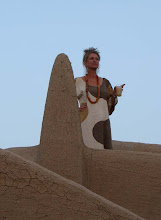The last bogolan cloth
Seven years later we found Satane still there, but now too
old and frail to work. Her daughters had not wanted to take up the bogolan, and
only one of her cloths remains. The
quality of this piece is far ,far higher than any other piece I have seen, and
anything that is for sale in Djenné’s commercial bogolan ateliers. ‘ My
daughters did not want to make bogolan , because it was too much work for very
little return, said Satane. ‘How long
did it take you to make this piece?’ I asked and she told me it could take up
to three weeks to make such a piece. ‘The
whites that came used to pay up to 15000FCFA(23E) for one like this’ said
Satane. Of course noone wants to work for three weeks for 23E any longer. However, this piece could take centre stage
in in the the most discerning of textile
connoisseurs’ collections, or for that matter it could be given pride of place
in any museum. It should by all rights fetch many hundreds of Euros, and should
it reach Europe it may do that one day, as a fine example of an art that has
disappeared. But the originator will
never see the money. Noone is willing to pay anything for African goods if it is not ancient sculpture. And therefore these are the very
last of these fantastic cloths that are now being made in the Malian bush. (picure courtesy of Catherine Reilly).
.jpg)


4 Comments:
Here's your meaning and purpose back in a day. And what a day! I well remember the trip with Max to Diabolo, and the dancing ladies rehearsing, as the most authentic of our trip (the other was stopping off on our pirogue trip down the Niger at a village, small town rather, where the inhabitants were genuinely curious to communicate with us, and didn't want to sell us things (or not insistently, anyway).
If the right people read this, the situation could, ought to, change. But even if it doesn't, you've documented it. I hope you have lots more photos that you haven't put up here.
I will take more tomorrow!And yes, I remember well the day we went to Diabolo- lovely times xxxs
That is gorgeous, and what you say about the cloth being undervalued is tragic--though I like what David has said, and may he be right!
Very beautiful and it's great that you're finding out about the traditional techniques.
Post a Comment
<< Home